CNUR 805: Nursing Reflection Paper: Totality vs Simultaneity
VerifiedAdded on 2022/12/02
|13
|3573
|328
Report
AI Summary
This nursing reflection paper, written by a student, explores the paradigms of totality and simultaneity in nursing, comparing personal definitions of key concepts (person, environment, health, and nurse) with Hildegard Peplau's theory of interpersonal relations. The paper begins with the student's personal definitions, shaped by clinical experiences, and analyzes them within the framework of the totality paradigm. It then contrasts these with Peplau's theory, which is situated within the simultaneity paradigm. The paper highlights the differences in how each paradigm conceptualizes the interaction between the individual and the environment, and the implications for nursing practice. The student uses clinical examples to illustrate the application of both paradigms, demonstrating an understanding of the complexities of patient care and the importance of both physiological and psychological aspects of health. The analysis also considers the role of the nurse as a healthcare professional and the significance of interpersonal relationships in achieving positive patient outcomes. The paper concludes with a comparison of the two paradigms and their implications for the student's approach to nursing practice.
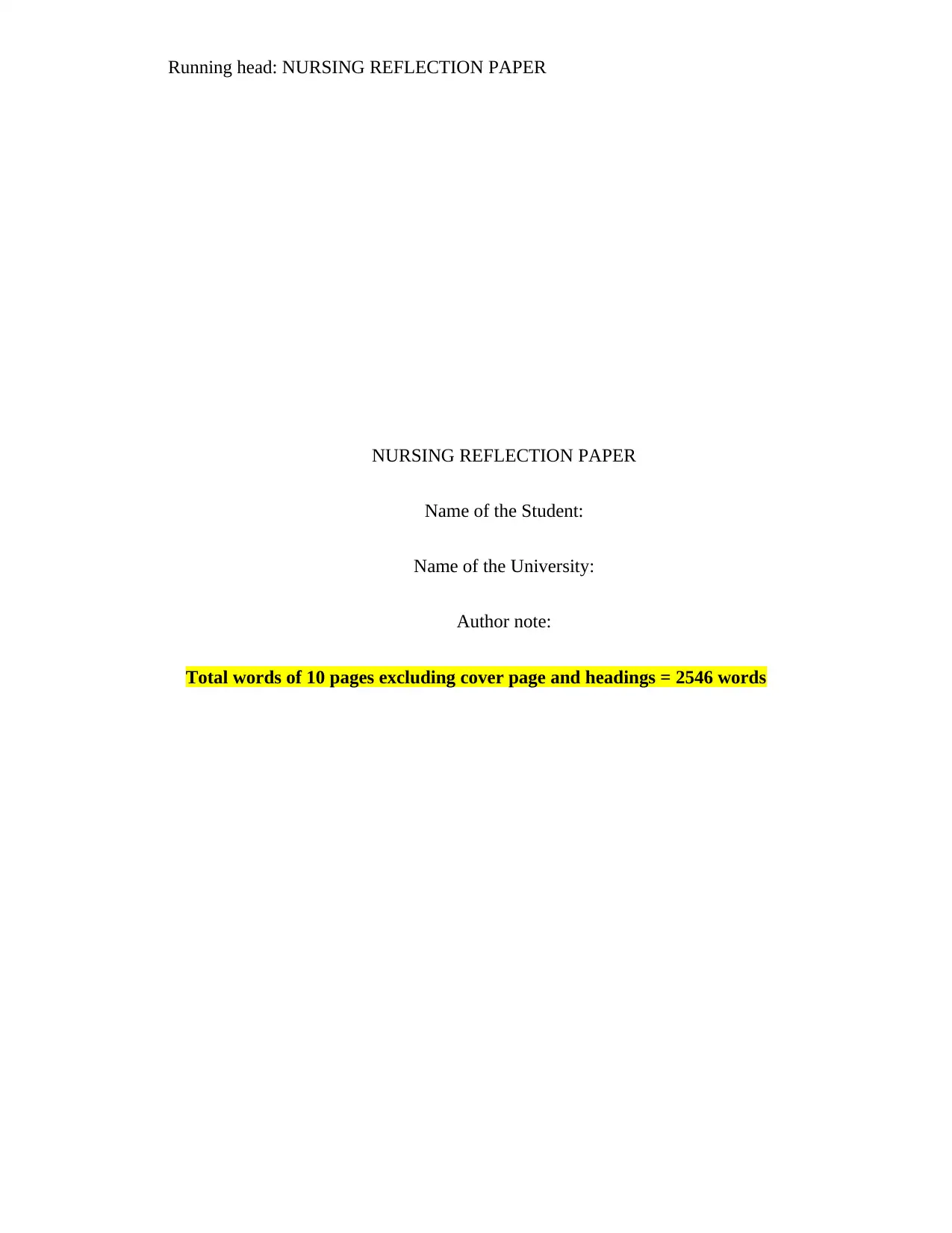
Running head: NURSING REFLECTION PAPER
NURSING REFLECTION PAPER
Name of the Student:
Name of the University:
Author note:
Total words of 10 pages excluding cover page and headings = 2546 words
NURSING REFLECTION PAPER
Name of the Student:
Name of the University:
Author note:
Total words of 10 pages excluding cover page and headings = 2546 words
Paraphrase This Document
Need a fresh take? Get an instant paraphrase of this document with our AI Paraphraser
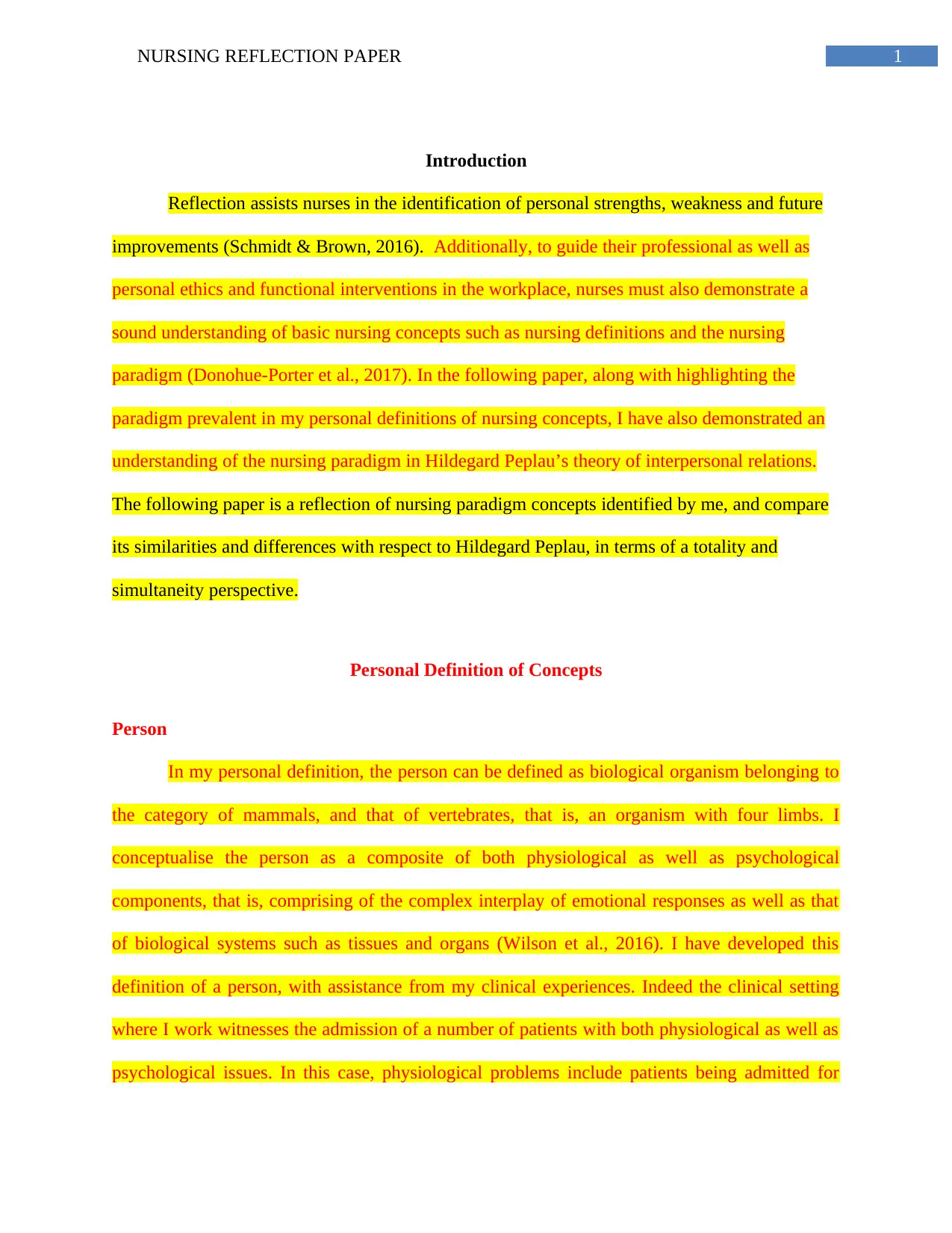
1NURSING REFLECTION PAPER
Introduction
Reflection assists nurses in the identification of personal strengths, weakness and future
improvements (Schmidt & Brown, 2016). Additionally, to guide their professional as well as
personal ethics and functional interventions in the workplace, nurses must also demonstrate a
sound understanding of basic nursing concepts such as nursing definitions and the nursing
paradigm (Donohue-Porter et al., 2017). In the following paper, along with highlighting the
paradigm prevalent in my personal definitions of nursing concepts, I have also demonstrated an
understanding of the nursing paradigm in Hildegard Peplau’s theory of interpersonal relations.
The following paper is a reflection of nursing paradigm concepts identified by me, and compare
its similarities and differences with respect to Hildegard Peplau, in terms of a totality and
simultaneity perspective.
Personal Definition of Concepts
Person
In my personal definition, the person can be defined as biological organism belonging to
the category of mammals, and that of vertebrates, that is, an organism with four limbs. I
conceptualise the person as a composite of both physiological as well as psychological
components, that is, comprising of the complex interplay of emotional responses as well as that
of biological systems such as tissues and organs (Wilson et al., 2016). I have developed this
definition of a person, with assistance from my clinical experiences. Indeed the clinical setting
where I work witnesses the admission of a number of patients with both physiological as well as
psychological issues. In this case, physiological problems include patients being admitted for
Introduction
Reflection assists nurses in the identification of personal strengths, weakness and future
improvements (Schmidt & Brown, 2016). Additionally, to guide their professional as well as
personal ethics and functional interventions in the workplace, nurses must also demonstrate a
sound understanding of basic nursing concepts such as nursing definitions and the nursing
paradigm (Donohue-Porter et al., 2017). In the following paper, along with highlighting the
paradigm prevalent in my personal definitions of nursing concepts, I have also demonstrated an
understanding of the nursing paradigm in Hildegard Peplau’s theory of interpersonal relations.
The following paper is a reflection of nursing paradigm concepts identified by me, and compare
its similarities and differences with respect to Hildegard Peplau, in terms of a totality and
simultaneity perspective.
Personal Definition of Concepts
Person
In my personal definition, the person can be defined as biological organism belonging to
the category of mammals, and that of vertebrates, that is, an organism with four limbs. I
conceptualise the person as a composite of both physiological as well as psychological
components, that is, comprising of the complex interplay of emotional responses as well as that
of biological systems such as tissues and organs (Wilson et al., 2016). I have developed this
definition of a person, with assistance from my clinical experiences. Indeed the clinical setting
where I work witnesses the admission of a number of patients with both physiological as well as
psychological issues. In this case, physiological problems include patients being admitted for
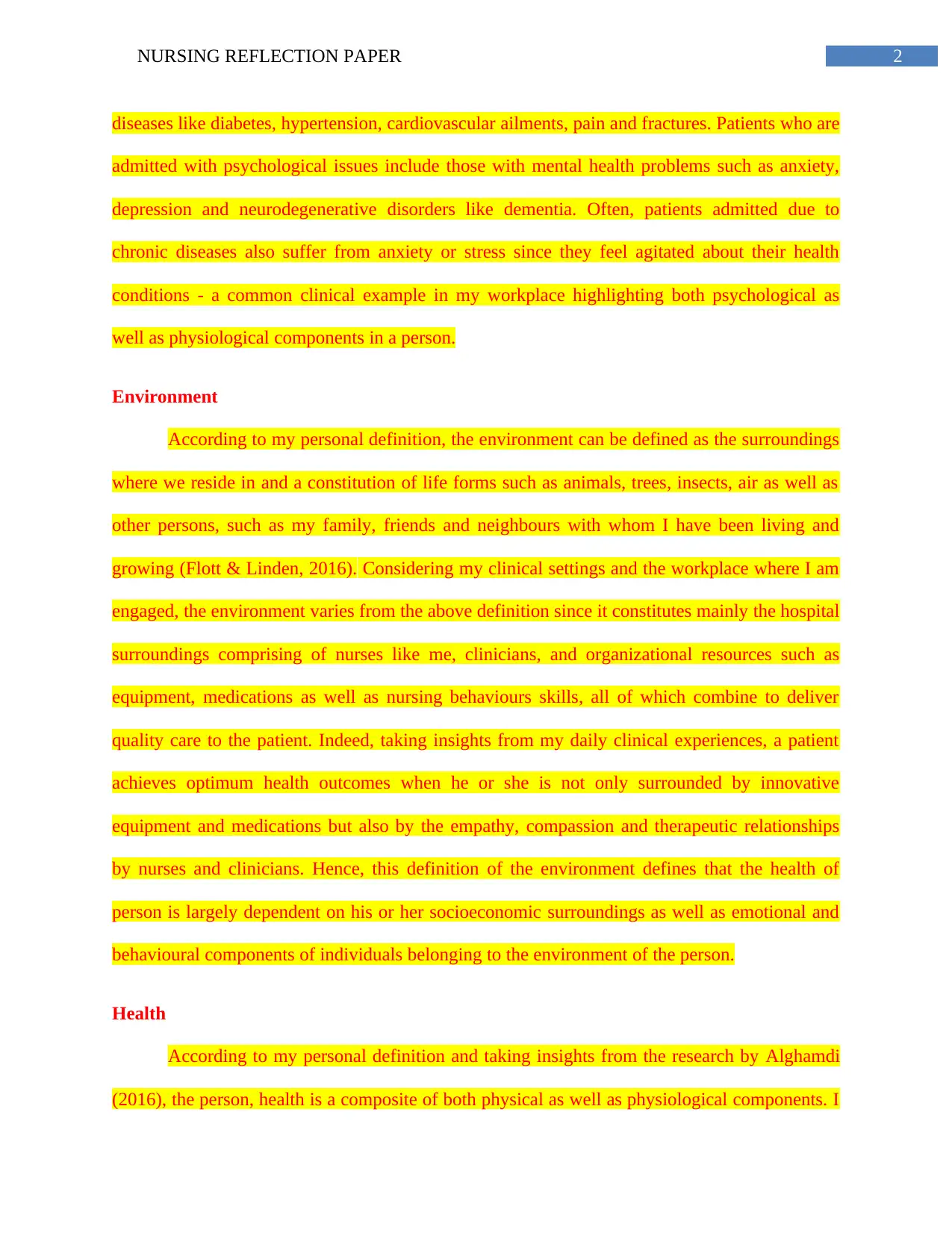
2NURSING REFLECTION PAPER
diseases like diabetes, hypertension, cardiovascular ailments, pain and fractures. Patients who are
admitted with psychological issues include those with mental health problems such as anxiety,
depression and neurodegenerative disorders like dementia. Often, patients admitted due to
chronic diseases also suffer from anxiety or stress since they feel agitated about their health
conditions - a common clinical example in my workplace highlighting both psychological as
well as physiological components in a person.
Environment
According to my personal definition, the environment can be defined as the surroundings
where we reside in and a constitution of life forms such as animals, trees, insects, air as well as
other persons, such as my family, friends and neighbours with whom I have been living and
growing (Flott & Linden, 2016). Considering my clinical settings and the workplace where I am
engaged, the environment varies from the above definition since it constitutes mainly the hospital
surroundings comprising of nurses like me, clinicians, and organizational resources such as
equipment, medications as well as nursing behaviours skills, all of which combine to deliver
quality care to the patient. Indeed, taking insights from my daily clinical experiences, a patient
achieves optimum health outcomes when he or she is not only surrounded by innovative
equipment and medications but also by the empathy, compassion and therapeutic relationships
by nurses and clinicians. Hence, this definition of the environment defines that the health of
person is largely dependent on his or her socioeconomic surroundings as well as emotional and
behavioural components of individuals belonging to the environment of the person.
Health
According to my personal definition and taking insights from the research by Alghamdi
(2016), the person, health is a composite of both physical as well as physiological components. I
diseases like diabetes, hypertension, cardiovascular ailments, pain and fractures. Patients who are
admitted with psychological issues include those with mental health problems such as anxiety,
depression and neurodegenerative disorders like dementia. Often, patients admitted due to
chronic diseases also suffer from anxiety or stress since they feel agitated about their health
conditions - a common clinical example in my workplace highlighting both psychological as
well as physiological components in a person.
Environment
According to my personal definition, the environment can be defined as the surroundings
where we reside in and a constitution of life forms such as animals, trees, insects, air as well as
other persons, such as my family, friends and neighbours with whom I have been living and
growing (Flott & Linden, 2016). Considering my clinical settings and the workplace where I am
engaged, the environment varies from the above definition since it constitutes mainly the hospital
surroundings comprising of nurses like me, clinicians, and organizational resources such as
equipment, medications as well as nursing behaviours skills, all of which combine to deliver
quality care to the patient. Indeed, taking insights from my daily clinical experiences, a patient
achieves optimum health outcomes when he or she is not only surrounded by innovative
equipment and medications but also by the empathy, compassion and therapeutic relationships
by nurses and clinicians. Hence, this definition of the environment defines that the health of
person is largely dependent on his or her socioeconomic surroundings as well as emotional and
behavioural components of individuals belonging to the environment of the person.
Health
According to my personal definition and taking insights from the research by Alghamdi
(2016), the person, health is a composite of both physical as well as physiological components. I
⊘ This is a preview!⊘
Do you want full access?
Subscribe today to unlock all pages.

Trusted by 1+ million students worldwide
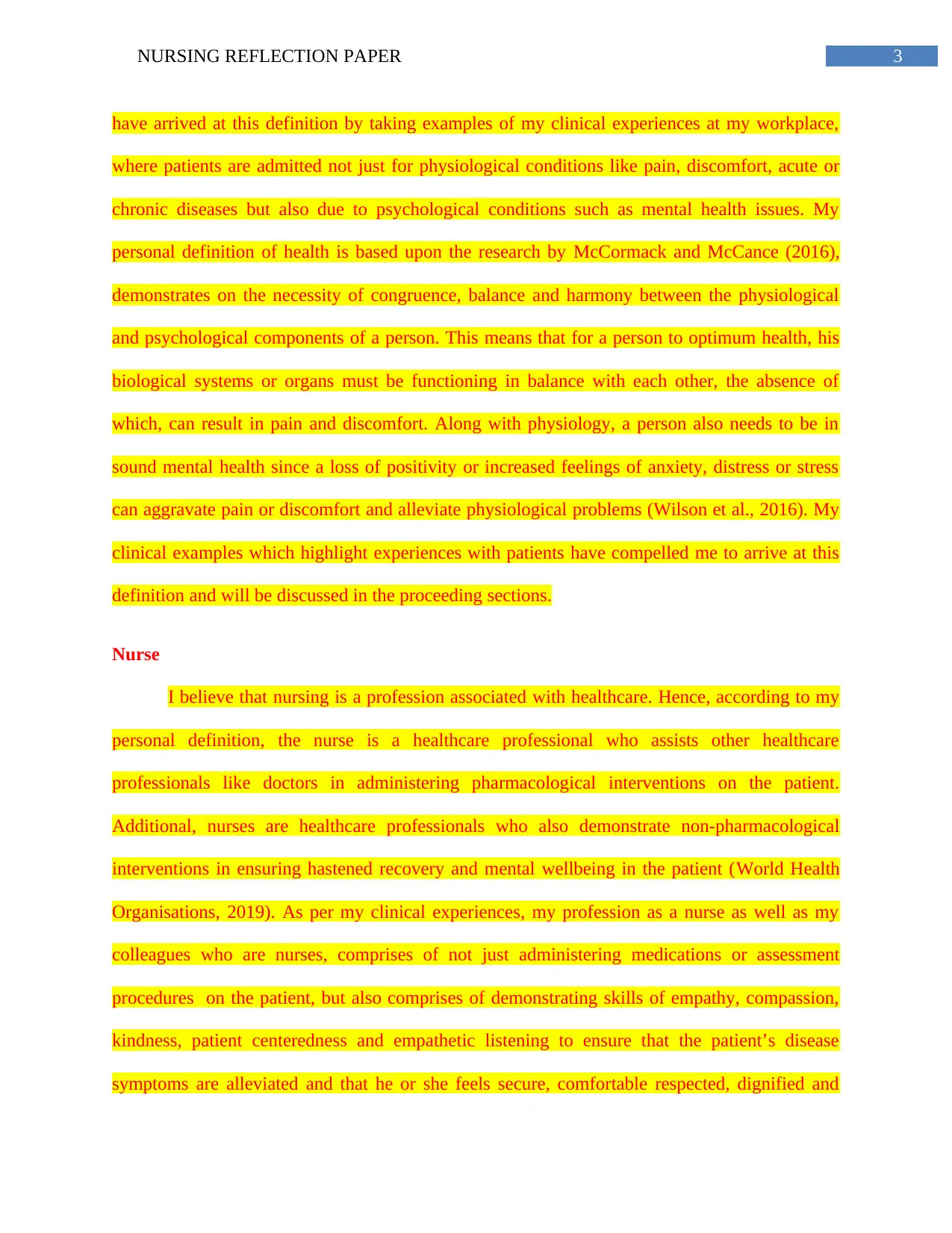
3NURSING REFLECTION PAPER
have arrived at this definition by taking examples of my clinical experiences at my workplace,
where patients are admitted not just for physiological conditions like pain, discomfort, acute or
chronic diseases but also due to psychological conditions such as mental health issues. My
personal definition of health is based upon the research by McCormack and McCance (2016),
demonstrates on the necessity of congruence, balance and harmony between the physiological
and psychological components of a person. This means that for a person to optimum health, his
biological systems or organs must be functioning in balance with each other, the absence of
which, can result in pain and discomfort. Along with physiology, a person also needs to be in
sound mental health since a loss of positivity or increased feelings of anxiety, distress or stress
can aggravate pain or discomfort and alleviate physiological problems (Wilson et al., 2016). My
clinical examples which highlight experiences with patients have compelled me to arrive at this
definition and will be discussed in the proceeding sections.
Nurse
I believe that nursing is a profession associated with healthcare. Hence, according to my
personal definition, the nurse is a healthcare professional who assists other healthcare
professionals like doctors in administering pharmacological interventions on the patient.
Additional, nurses are healthcare professionals who also demonstrate non-pharmacological
interventions in ensuring hastened recovery and mental wellbeing in the patient (World Health
Organisations, 2019). As per my clinical experiences, my profession as a nurse as well as my
colleagues who are nurses, comprises of not just administering medications or assessment
procedures on the patient, but also comprises of demonstrating skills of empathy, compassion,
kindness, patient centeredness and empathetic listening to ensure that the patient’s disease
symptoms are alleviated and that he or she feels secure, comfortable respected, dignified and
have arrived at this definition by taking examples of my clinical experiences at my workplace,
where patients are admitted not just for physiological conditions like pain, discomfort, acute or
chronic diseases but also due to psychological conditions such as mental health issues. My
personal definition of health is based upon the research by McCormack and McCance (2016),
demonstrates on the necessity of congruence, balance and harmony between the physiological
and psychological components of a person. This means that for a person to optimum health, his
biological systems or organs must be functioning in balance with each other, the absence of
which, can result in pain and discomfort. Along with physiology, a person also needs to be in
sound mental health since a loss of positivity or increased feelings of anxiety, distress or stress
can aggravate pain or discomfort and alleviate physiological problems (Wilson et al., 2016). My
clinical examples which highlight experiences with patients have compelled me to arrive at this
definition and will be discussed in the proceeding sections.
Nurse
I believe that nursing is a profession associated with healthcare. Hence, according to my
personal definition, the nurse is a healthcare professional who assists other healthcare
professionals like doctors in administering pharmacological interventions on the patient.
Additional, nurses are healthcare professionals who also demonstrate non-pharmacological
interventions in ensuring hastened recovery and mental wellbeing in the patient (World Health
Organisations, 2019). As per my clinical experiences, my profession as a nurse as well as my
colleagues who are nurses, comprises of not just administering medications or assessment
procedures on the patient, but also comprises of demonstrating skills of empathy, compassion,
kindness, patient centeredness and empathetic listening to ensure that the patient’s disease
symptoms are alleviated and that he or she feels secure, comfortable respected, dignified and
Paraphrase This Document
Need a fresh take? Get an instant paraphrase of this document with our AI Paraphraser
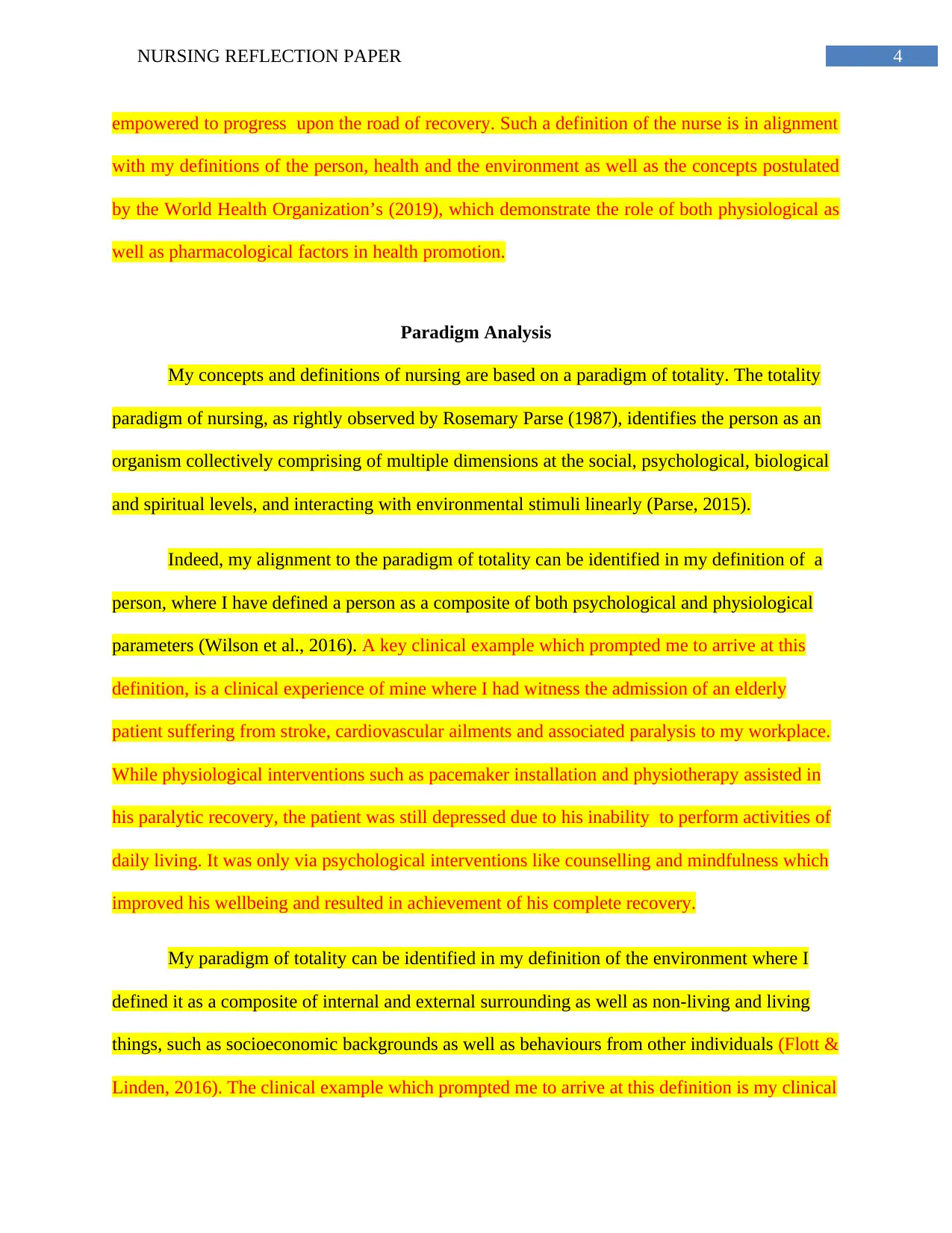
4NURSING REFLECTION PAPER
empowered to progress upon the road of recovery. Such a definition of the nurse is in alignment
with my definitions of the person, health and the environment as well as the concepts postulated
by the World Health Organization’s (2019), which demonstrate the role of both physiological as
well as pharmacological factors in health promotion.
Paradigm Analysis
My concepts and definitions of nursing are based on a paradigm of totality. The totality
paradigm of nursing, as rightly observed by Rosemary Parse (1987), identifies the person as an
organism collectively comprising of multiple dimensions at the social, psychological, biological
and spiritual levels, and interacting with environmental stimuli linearly (Parse, 2015).
Indeed, my alignment to the paradigm of totality can be identified in my definition of a
person, where I have defined a person as a composite of both psychological and physiological
parameters (Wilson et al., 2016). A key clinical example which prompted me to arrive at this
definition, is a clinical experience of mine where I had witness the admission of an elderly
patient suffering from stroke, cardiovascular ailments and associated paralysis to my workplace.
While physiological interventions such as pacemaker installation and physiotherapy assisted in
his paralytic recovery, the patient was still depressed due to his inability to perform activities of
daily living. It was only via psychological interventions like counselling and mindfulness which
improved his wellbeing and resulted in achievement of his complete recovery.
My paradigm of totality can be identified in my definition of the environment where I
defined it as a composite of internal and external surrounding as well as non-living and living
things, such as socioeconomic backgrounds as well as behaviours from other individuals (Flott &
Linden, 2016). The clinical example which prompted me to arrive at this definition is my clinical
empowered to progress upon the road of recovery. Such a definition of the nurse is in alignment
with my definitions of the person, health and the environment as well as the concepts postulated
by the World Health Organization’s (2019), which demonstrate the role of both physiological as
well as pharmacological factors in health promotion.
Paradigm Analysis
My concepts and definitions of nursing are based on a paradigm of totality. The totality
paradigm of nursing, as rightly observed by Rosemary Parse (1987), identifies the person as an
organism collectively comprising of multiple dimensions at the social, psychological, biological
and spiritual levels, and interacting with environmental stimuli linearly (Parse, 2015).
Indeed, my alignment to the paradigm of totality can be identified in my definition of a
person, where I have defined a person as a composite of both psychological and physiological
parameters (Wilson et al., 2016). A key clinical example which prompted me to arrive at this
definition, is a clinical experience of mine where I had witness the admission of an elderly
patient suffering from stroke, cardiovascular ailments and associated paralysis to my workplace.
While physiological interventions such as pacemaker installation and physiotherapy assisted in
his paralytic recovery, the patient was still depressed due to his inability to perform activities of
daily living. It was only via psychological interventions like counselling and mindfulness which
improved his wellbeing and resulted in achievement of his complete recovery.
My paradigm of totality can be identified in my definition of the environment where I
defined it as a composite of internal and external surrounding as well as non-living and living
things, such as socioeconomic backgrounds as well as behaviours from other individuals (Flott &
Linden, 2016). The clinical example which prompted me to arrive at this definition is my clinical
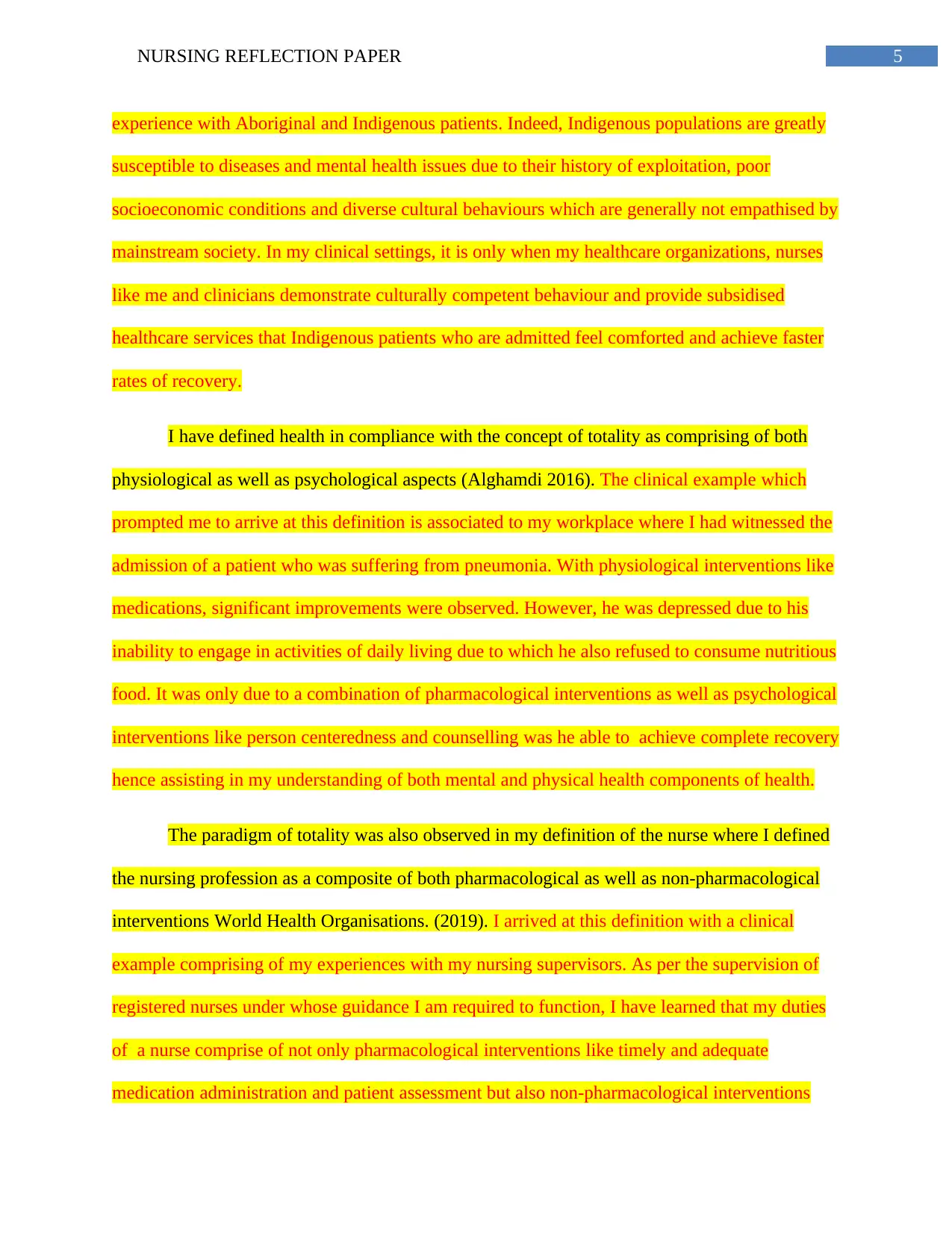
5NURSING REFLECTION PAPER
experience with Aboriginal and Indigenous patients. Indeed, Indigenous populations are greatly
susceptible to diseases and mental health issues due to their history of exploitation, poor
socioeconomic conditions and diverse cultural behaviours which are generally not empathised by
mainstream society. In my clinical settings, it is only when my healthcare organizations, nurses
like me and clinicians demonstrate culturally competent behaviour and provide subsidised
healthcare services that Indigenous patients who are admitted feel comforted and achieve faster
rates of recovery.
I have defined health in compliance with the concept of totality as comprising of both
physiological as well as psychological aspects (Alghamdi 2016). The clinical example which
prompted me to arrive at this definition is associated to my workplace where I had witnessed the
admission of a patient who was suffering from pneumonia. With physiological interventions like
medications, significant improvements were observed. However, he was depressed due to his
inability to engage in activities of daily living due to which he also refused to consume nutritious
food. It was only due to a combination of pharmacological interventions as well as psychological
interventions like person centeredness and counselling was he able to achieve complete recovery
hence assisting in my understanding of both mental and physical health components of health.
The paradigm of totality was also observed in my definition of the nurse where I defined
the nursing profession as a composite of both pharmacological as well as non-pharmacological
interventions World Health Organisations. (2019). I arrived at this definition with a clinical
example comprising of my experiences with my nursing supervisors. As per the supervision of
registered nurses under whose guidance I am required to function, I have learned that my duties
of a nurse comprise of not only pharmacological interventions like timely and adequate
medication administration and patient assessment but also non-pharmacological interventions
experience with Aboriginal and Indigenous patients. Indeed, Indigenous populations are greatly
susceptible to diseases and mental health issues due to their history of exploitation, poor
socioeconomic conditions and diverse cultural behaviours which are generally not empathised by
mainstream society. In my clinical settings, it is only when my healthcare organizations, nurses
like me and clinicians demonstrate culturally competent behaviour and provide subsidised
healthcare services that Indigenous patients who are admitted feel comforted and achieve faster
rates of recovery.
I have defined health in compliance with the concept of totality as comprising of both
physiological as well as psychological aspects (Alghamdi 2016). The clinical example which
prompted me to arrive at this definition is associated to my workplace where I had witnessed the
admission of a patient who was suffering from pneumonia. With physiological interventions like
medications, significant improvements were observed. However, he was depressed due to his
inability to engage in activities of daily living due to which he also refused to consume nutritious
food. It was only due to a combination of pharmacological interventions as well as psychological
interventions like person centeredness and counselling was he able to achieve complete recovery
hence assisting in my understanding of both mental and physical health components of health.
The paradigm of totality was also observed in my definition of the nurse where I defined
the nursing profession as a composite of both pharmacological as well as non-pharmacological
interventions World Health Organisations. (2019). I arrived at this definition with a clinical
example comprising of my experiences with my nursing supervisors. As per the supervision of
registered nurses under whose guidance I am required to function, I have learned that my duties
of a nurse comprise of not only pharmacological interventions like timely and adequate
medication administration and patient assessment but also non-pharmacological interventions
⊘ This is a preview!⊘
Do you want full access?
Subscribe today to unlock all pages.

Trusted by 1+ million students worldwide
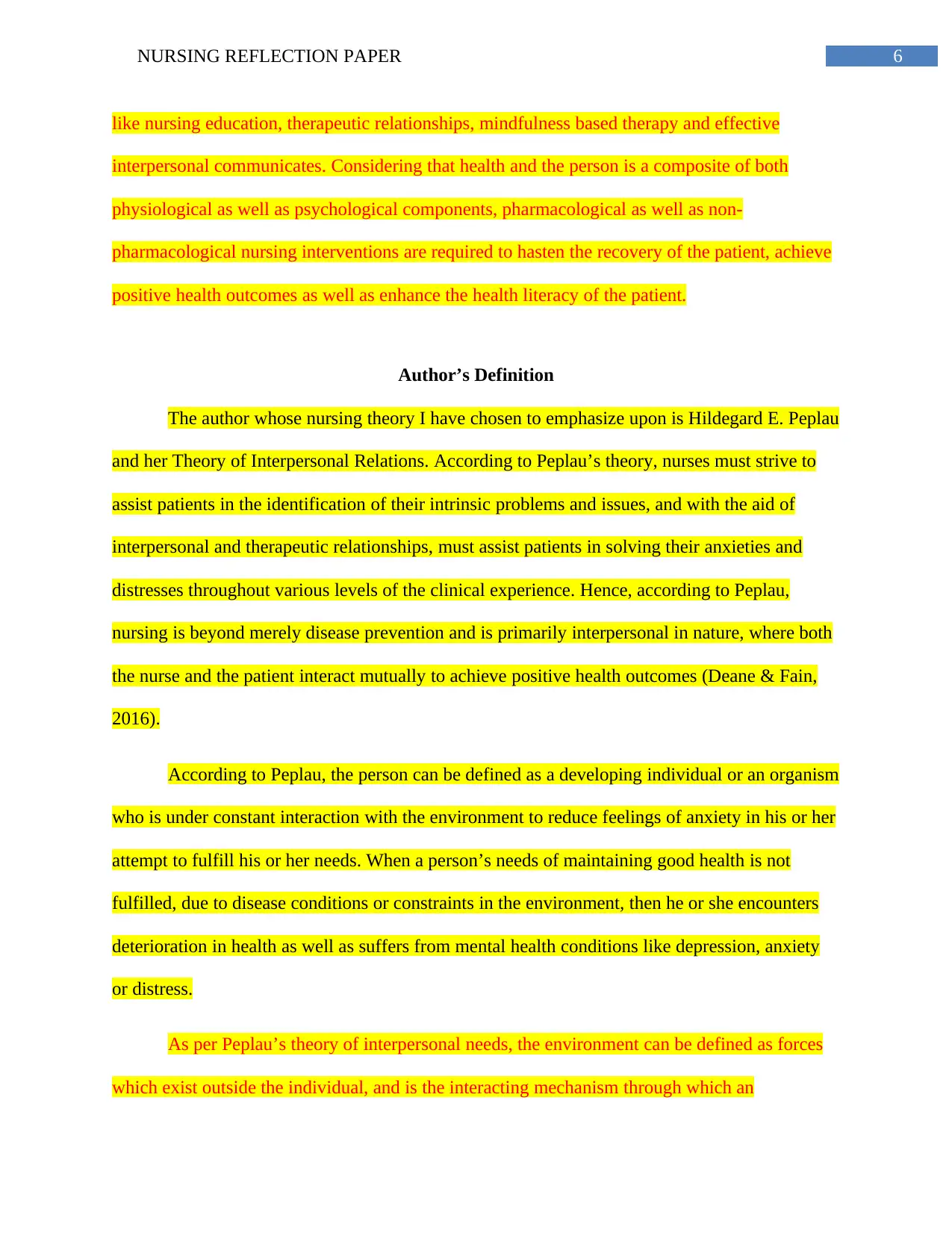
6NURSING REFLECTION PAPER
like nursing education, therapeutic relationships, mindfulness based therapy and effective
interpersonal communicates. Considering that health and the person is a composite of both
physiological as well as psychological components, pharmacological as well as non-
pharmacological nursing interventions are required to hasten the recovery of the patient, achieve
positive health outcomes as well as enhance the health literacy of the patient.
Author’s Definition
The author whose nursing theory I have chosen to emphasize upon is Hildegard E. Peplau
and her Theory of Interpersonal Relations. According to Peplau’s theory, nurses must strive to
assist patients in the identification of their intrinsic problems and issues, and with the aid of
interpersonal and therapeutic relationships, must assist patients in solving their anxieties and
distresses throughout various levels of the clinical experience. Hence, according to Peplau,
nursing is beyond merely disease prevention and is primarily interpersonal in nature, where both
the nurse and the patient interact mutually to achieve positive health outcomes (Deane & Fain,
2016).
According to Peplau, the person can be defined as a developing individual or an organism
who is under constant interaction with the environment to reduce feelings of anxiety in his or her
attempt to fulfill his or her needs. When a person’s needs of maintaining good health is not
fulfilled, due to disease conditions or constraints in the environment, then he or she encounters
deterioration in health as well as suffers from mental health conditions like depression, anxiety
or distress.
As per Peplau’s theory of interpersonal needs, the environment can be defined as forces
which exist outside the individual, and is the interacting mechanism through which an
like nursing education, therapeutic relationships, mindfulness based therapy and effective
interpersonal communicates. Considering that health and the person is a composite of both
physiological as well as psychological components, pharmacological as well as non-
pharmacological nursing interventions are required to hasten the recovery of the patient, achieve
positive health outcomes as well as enhance the health literacy of the patient.
Author’s Definition
The author whose nursing theory I have chosen to emphasize upon is Hildegard E. Peplau
and her Theory of Interpersonal Relations. According to Peplau’s theory, nurses must strive to
assist patients in the identification of their intrinsic problems and issues, and with the aid of
interpersonal and therapeutic relationships, must assist patients in solving their anxieties and
distresses throughout various levels of the clinical experience. Hence, according to Peplau,
nursing is beyond merely disease prevention and is primarily interpersonal in nature, where both
the nurse and the patient interact mutually to achieve positive health outcomes (Deane & Fain,
2016).
According to Peplau, the person can be defined as a developing individual or an organism
who is under constant interaction with the environment to reduce feelings of anxiety in his or her
attempt to fulfill his or her needs. When a person’s needs of maintaining good health is not
fulfilled, due to disease conditions or constraints in the environment, then he or she encounters
deterioration in health as well as suffers from mental health conditions like depression, anxiety
or distress.
As per Peplau’s theory of interpersonal needs, the environment can be defined as forces
which exist outside the individual, and is the interacting mechanism through which an
Paraphrase This Document
Need a fresh take? Get an instant paraphrase of this document with our AI Paraphraser
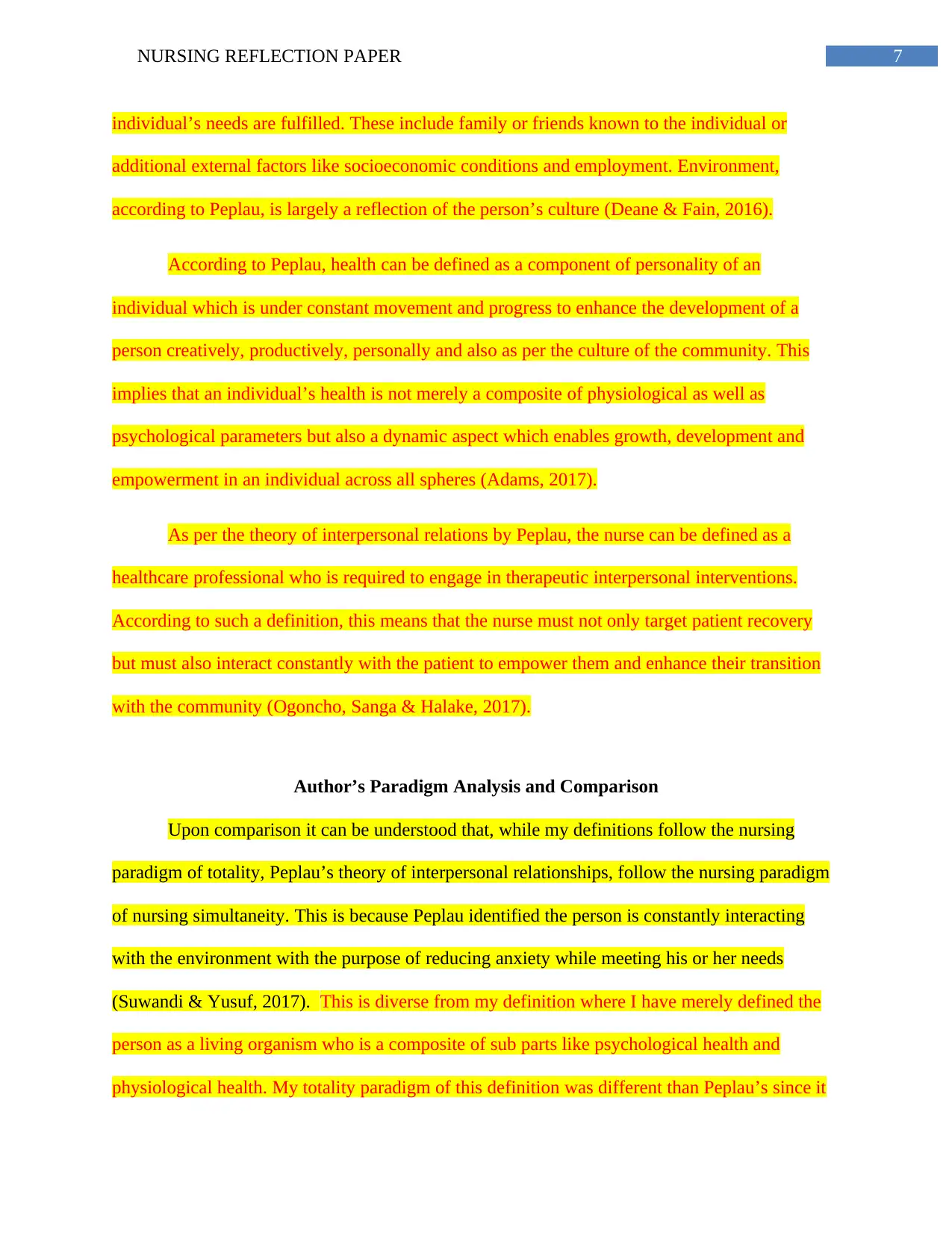
7NURSING REFLECTION PAPER
individual’s needs are fulfilled. These include family or friends known to the individual or
additional external factors like socioeconomic conditions and employment. Environment,
according to Peplau, is largely a reflection of the person’s culture (Deane & Fain, 2016).
According to Peplau, health can be defined as a component of personality of an
individual which is under constant movement and progress to enhance the development of a
person creatively, productively, personally and also as per the culture of the community. This
implies that an individual’s health is not merely a composite of physiological as well as
psychological parameters but also a dynamic aspect which enables growth, development and
empowerment in an individual across all spheres (Adams, 2017).
As per the theory of interpersonal relations by Peplau, the nurse can be defined as a
healthcare professional who is required to engage in therapeutic interpersonal interventions.
According to such a definition, this means that the nurse must not only target patient recovery
but must also interact constantly with the patient to empower them and enhance their transition
with the community (Ogoncho, Sanga & Halake, 2017).
Author’s Paradigm Analysis and Comparison
Upon comparison it can be understood that, while my definitions follow the nursing
paradigm of totality, Peplau’s theory of interpersonal relationships, follow the nursing paradigm
of nursing simultaneity. This is because Peplau identified the person is constantly interacting
with the environment with the purpose of reducing anxiety while meeting his or her needs
(Suwandi & Yusuf, 2017). This is diverse from my definition where I have merely defined the
person as a living organism who is a composite of sub parts like psychological health and
physiological health. My totality paradigm of this definition was different than Peplau’s since it
individual’s needs are fulfilled. These include family or friends known to the individual or
additional external factors like socioeconomic conditions and employment. Environment,
according to Peplau, is largely a reflection of the person’s culture (Deane & Fain, 2016).
According to Peplau, health can be defined as a component of personality of an
individual which is under constant movement and progress to enhance the development of a
person creatively, productively, personally and also as per the culture of the community. This
implies that an individual’s health is not merely a composite of physiological as well as
psychological parameters but also a dynamic aspect which enables growth, development and
empowerment in an individual across all spheres (Adams, 2017).
As per the theory of interpersonal relations by Peplau, the nurse can be defined as a
healthcare professional who is required to engage in therapeutic interpersonal interventions.
According to such a definition, this means that the nurse must not only target patient recovery
but must also interact constantly with the patient to empower them and enhance their transition
with the community (Ogoncho, Sanga & Halake, 2017).
Author’s Paradigm Analysis and Comparison
Upon comparison it can be understood that, while my definitions follow the nursing
paradigm of totality, Peplau’s theory of interpersonal relationships, follow the nursing paradigm
of nursing simultaneity. This is because Peplau identified the person is constantly interacting
with the environment with the purpose of reducing anxiety while meeting his or her needs
(Suwandi & Yusuf, 2017). This is diverse from my definition where I have merely defined the
person as a living organism who is a composite of sub parts like psychological health and
physiological health. My totality paradigm of this definition was different than Peplau’s since it
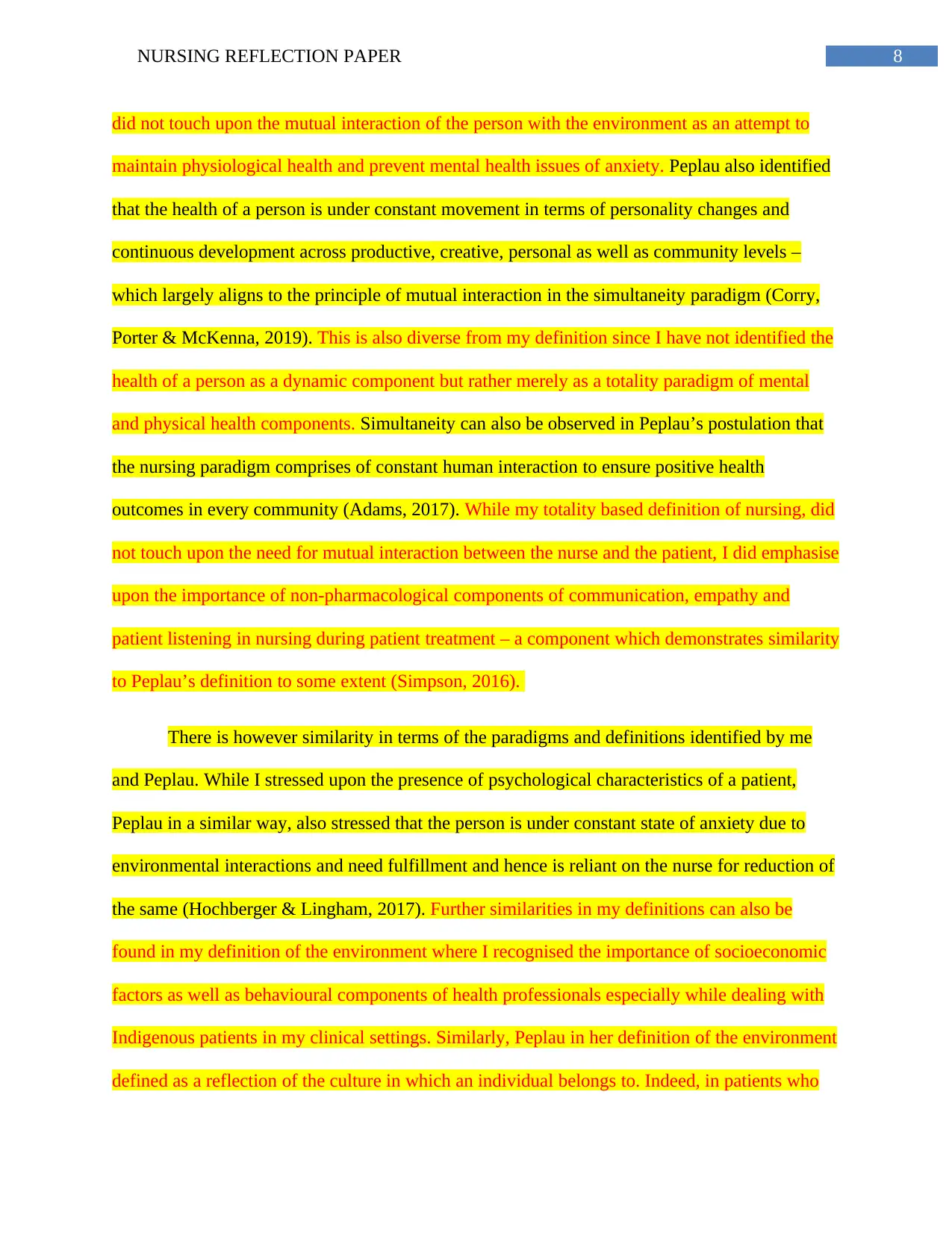
8NURSING REFLECTION PAPER
did not touch upon the mutual interaction of the person with the environment as an attempt to
maintain physiological health and prevent mental health issues of anxiety. Peplau also identified
that the health of a person is under constant movement in terms of personality changes and
continuous development across productive, creative, personal as well as community levels –
which largely aligns to the principle of mutual interaction in the simultaneity paradigm (Corry,
Porter & McKenna, 2019). This is also diverse from my definition since I have not identified the
health of a person as a dynamic component but rather merely as a totality paradigm of mental
and physical health components. Simultaneity can also be observed in Peplau’s postulation that
the nursing paradigm comprises of constant human interaction to ensure positive health
outcomes in every community (Adams, 2017). While my totality based definition of nursing, did
not touch upon the need for mutual interaction between the nurse and the patient, I did emphasise
upon the importance of non-pharmacological components of communication, empathy and
patient listening in nursing during patient treatment – a component which demonstrates similarity
to Peplau’s definition to some extent (Simpson, 2016).
There is however similarity in terms of the paradigms and definitions identified by me
and Peplau. While I stressed upon the presence of psychological characteristics of a patient,
Peplau in a similar way, also stressed that the person is under constant state of anxiety due to
environmental interactions and need fulfillment and hence is reliant on the nurse for reduction of
the same (Hochberger & Lingham, 2017). Further similarities in my definitions can also be
found in my definition of the environment where I recognised the importance of socioeconomic
factors as well as behavioural components of health professionals especially while dealing with
Indigenous patients in my clinical settings. Similarly, Peplau in her definition of the environment
defined as a reflection of the culture in which an individual belongs to. Indeed, in patients who
did not touch upon the mutual interaction of the person with the environment as an attempt to
maintain physiological health and prevent mental health issues of anxiety. Peplau also identified
that the health of a person is under constant movement in terms of personality changes and
continuous development across productive, creative, personal as well as community levels –
which largely aligns to the principle of mutual interaction in the simultaneity paradigm (Corry,
Porter & McKenna, 2019). This is also diverse from my definition since I have not identified the
health of a person as a dynamic component but rather merely as a totality paradigm of mental
and physical health components. Simultaneity can also be observed in Peplau’s postulation that
the nursing paradigm comprises of constant human interaction to ensure positive health
outcomes in every community (Adams, 2017). While my totality based definition of nursing, did
not touch upon the need for mutual interaction between the nurse and the patient, I did emphasise
upon the importance of non-pharmacological components of communication, empathy and
patient listening in nursing during patient treatment – a component which demonstrates similarity
to Peplau’s definition to some extent (Simpson, 2016).
There is however similarity in terms of the paradigms and definitions identified by me
and Peplau. While I stressed upon the presence of psychological characteristics of a patient,
Peplau in a similar way, also stressed that the person is under constant state of anxiety due to
environmental interactions and need fulfillment and hence is reliant on the nurse for reduction of
the same (Hochberger & Lingham, 2017). Further similarities in my definitions can also be
found in my definition of the environment where I recognised the importance of socioeconomic
factors as well as behavioural components of health professionals especially while dealing with
Indigenous patients in my clinical settings. Similarly, Peplau in her definition of the environment
defined as a reflection of the culture in which an individual belongs to. Indeed, in patients who
⊘ This is a preview!⊘
Do you want full access?
Subscribe today to unlock all pages.

Trusted by 1+ million students worldwide
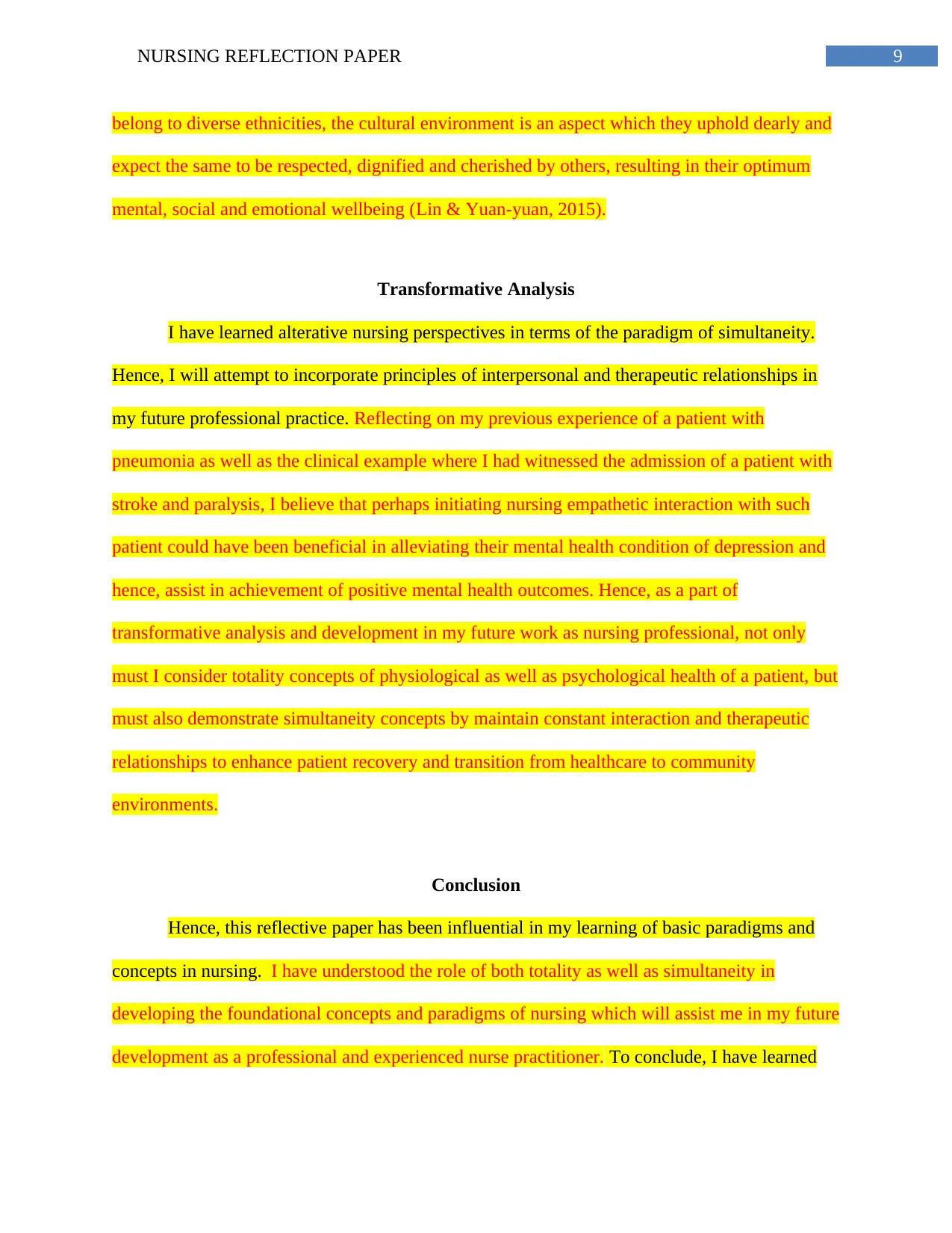
9NURSING REFLECTION PAPER
belong to diverse ethnicities, the cultural environment is an aspect which they uphold dearly and
expect the same to be respected, dignified and cherished by others, resulting in their optimum
mental, social and emotional wellbeing (Lin & Yuan-yuan, 2015).
Transformative Analysis
I have learned alterative nursing perspectives in terms of the paradigm of simultaneity.
Hence, I will attempt to incorporate principles of interpersonal and therapeutic relationships in
my future professional practice. Reflecting on my previous experience of a patient with
pneumonia as well as the clinical example where I had witnessed the admission of a patient with
stroke and paralysis, I believe that perhaps initiating nursing empathetic interaction with such
patient could have been beneficial in alleviating their mental health condition of depression and
hence, assist in achievement of positive mental health outcomes. Hence, as a part of
transformative analysis and development in my future work as nursing professional, not only
must I consider totality concepts of physiological as well as psychological health of a patient, but
must also demonstrate simultaneity concepts by maintain constant interaction and therapeutic
relationships to enhance patient recovery and transition from healthcare to community
environments.
Conclusion
Hence, this reflective paper has been influential in my learning of basic paradigms and
concepts in nursing. I have understood the role of both totality as well as simultaneity in
developing the foundational concepts and paradigms of nursing which will assist me in my future
development as a professional and experienced nurse practitioner. To conclude, I have learned
belong to diverse ethnicities, the cultural environment is an aspect which they uphold dearly and
expect the same to be respected, dignified and cherished by others, resulting in their optimum
mental, social and emotional wellbeing (Lin & Yuan-yuan, 2015).
Transformative Analysis
I have learned alterative nursing perspectives in terms of the paradigm of simultaneity.
Hence, I will attempt to incorporate principles of interpersonal and therapeutic relationships in
my future professional practice. Reflecting on my previous experience of a patient with
pneumonia as well as the clinical example where I had witnessed the admission of a patient with
stroke and paralysis, I believe that perhaps initiating nursing empathetic interaction with such
patient could have been beneficial in alleviating their mental health condition of depression and
hence, assist in achievement of positive mental health outcomes. Hence, as a part of
transformative analysis and development in my future work as nursing professional, not only
must I consider totality concepts of physiological as well as psychological health of a patient, but
must also demonstrate simultaneity concepts by maintain constant interaction and therapeutic
relationships to enhance patient recovery and transition from healthcare to community
environments.
Conclusion
Hence, this reflective paper has been influential in my learning of basic paradigms and
concepts in nursing. I have understood the role of both totality as well as simultaneity in
developing the foundational concepts and paradigms of nursing which will assist me in my future
development as a professional and experienced nurse practitioner. To conclude, I have learned
Paraphrase This Document
Need a fresh take? Get an instant paraphrase of this document with our AI Paraphraser
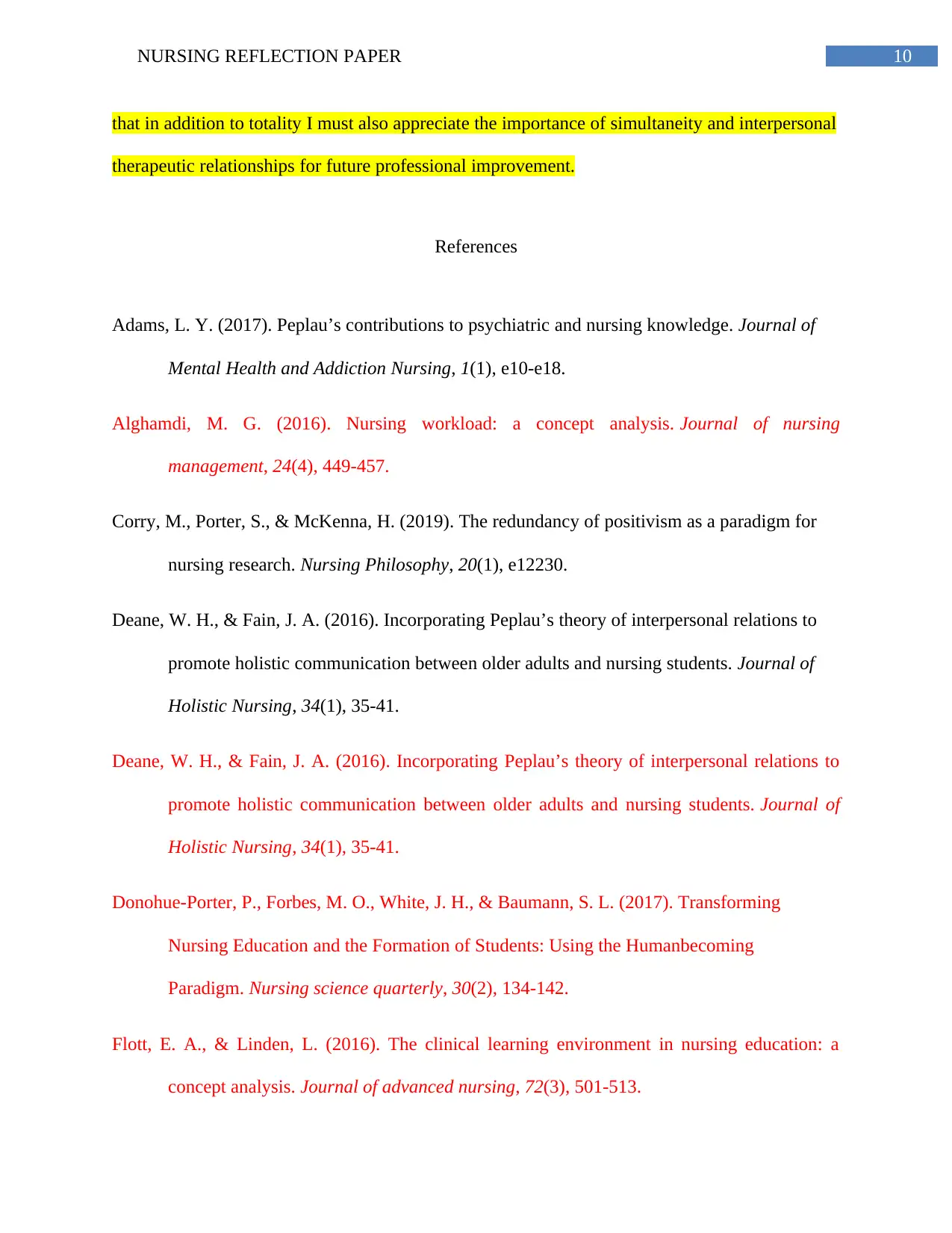
10NURSING REFLECTION PAPER
that in addition to totality I must also appreciate the importance of simultaneity and interpersonal
therapeutic relationships for future professional improvement.
References
Adams, L. Y. (2017). Peplau’s contributions to psychiatric and nursing knowledge. Journal of
Mental Health and Addiction Nursing, 1(1), e10-e18.
Alghamdi, M. G. (2016). Nursing workload: a concept analysis. Journal of nursing
management, 24(4), 449-457.
Corry, M., Porter, S., & McKenna, H. (2019). The redundancy of positivism as a paradigm for
nursing research. Nursing Philosophy, 20(1), e12230.
Deane, W. H., & Fain, J. A. (2016). Incorporating Peplau’s theory of interpersonal relations to
promote holistic communication between older adults and nursing students. Journal of
Holistic Nursing, 34(1), 35-41.
Deane, W. H., & Fain, J. A. (2016). Incorporating Peplau’s theory of interpersonal relations to
promote holistic communication between older adults and nursing students. Journal of
Holistic Nursing, 34(1), 35-41.
Donohue-Porter, P., Forbes, M. O., White, J. H., & Baumann, S. L. (2017). Transforming
Nursing Education and the Formation of Students: Using the Humanbecoming
Paradigm. Nursing science quarterly, 30(2), 134-142.
Flott, E. A., & Linden, L. (2016). The clinical learning environment in nursing education: a
concept analysis. Journal of advanced nursing, 72(3), 501-513.
that in addition to totality I must also appreciate the importance of simultaneity and interpersonal
therapeutic relationships for future professional improvement.
References
Adams, L. Y. (2017). Peplau’s contributions to psychiatric and nursing knowledge. Journal of
Mental Health and Addiction Nursing, 1(1), e10-e18.
Alghamdi, M. G. (2016). Nursing workload: a concept analysis. Journal of nursing
management, 24(4), 449-457.
Corry, M., Porter, S., & McKenna, H. (2019). The redundancy of positivism as a paradigm for
nursing research. Nursing Philosophy, 20(1), e12230.
Deane, W. H., & Fain, J. A. (2016). Incorporating Peplau’s theory of interpersonal relations to
promote holistic communication between older adults and nursing students. Journal of
Holistic Nursing, 34(1), 35-41.
Deane, W. H., & Fain, J. A. (2016). Incorporating Peplau’s theory of interpersonal relations to
promote holistic communication between older adults and nursing students. Journal of
Holistic Nursing, 34(1), 35-41.
Donohue-Porter, P., Forbes, M. O., White, J. H., & Baumann, S. L. (2017). Transforming
Nursing Education and the Formation of Students: Using the Humanbecoming
Paradigm. Nursing science quarterly, 30(2), 134-142.
Flott, E. A., & Linden, L. (2016). The clinical learning environment in nursing education: a
concept analysis. Journal of advanced nursing, 72(3), 501-513.
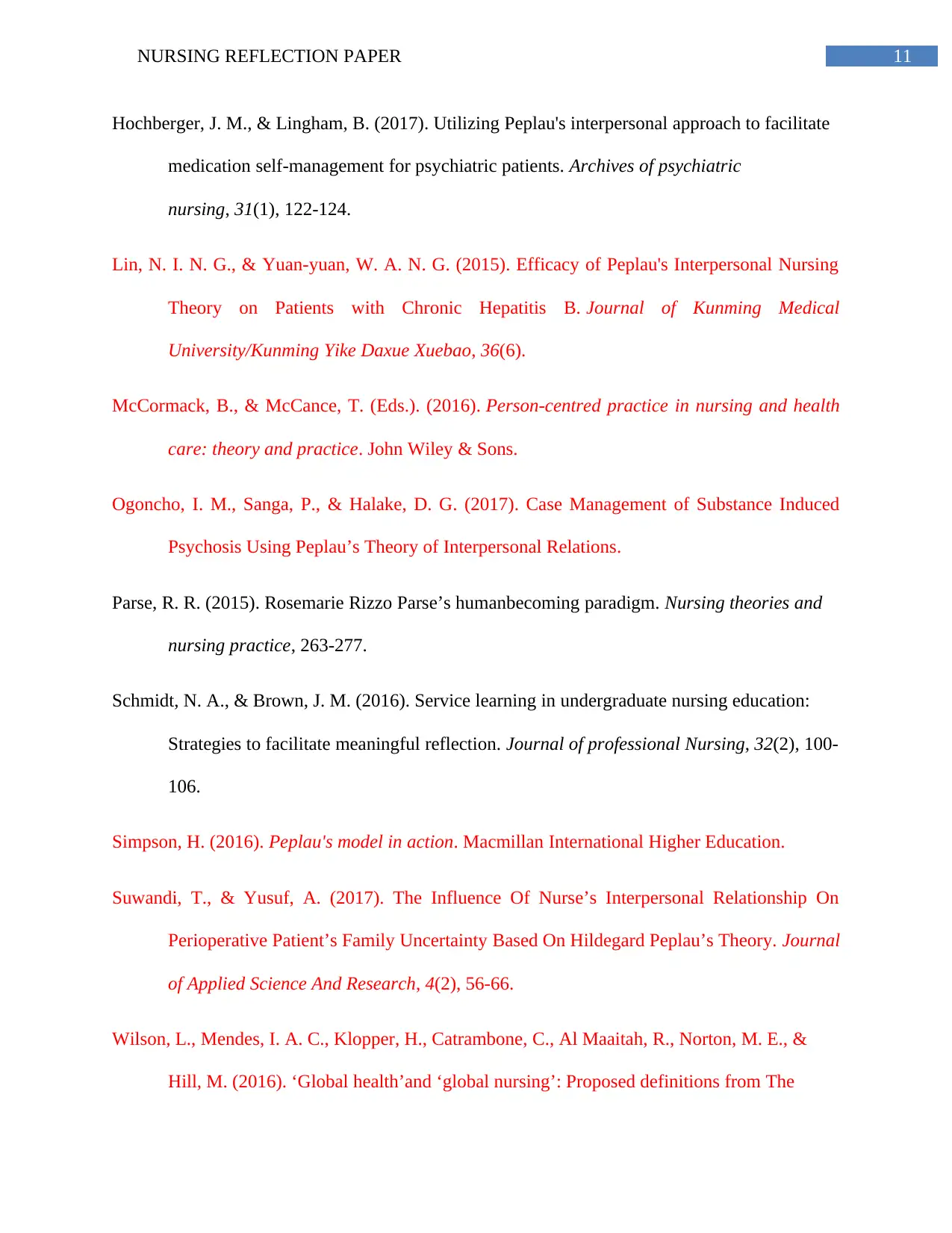
11NURSING REFLECTION PAPER
Hochberger, J. M., & Lingham, B. (2017). Utilizing Peplau's interpersonal approach to facilitate
medication self-management for psychiatric patients. Archives of psychiatric
nursing, 31(1), 122-124.
Lin, N. I. N. G., & Yuan-yuan, W. A. N. G. (2015). Efficacy of Peplau's Interpersonal Nursing
Theory on Patients with Chronic Hepatitis B. Journal of Kunming Medical
University/Kunming Yike Daxue Xuebao, 36(6).
McCormack, B., & McCance, T. (Eds.). (2016). Person-centred practice in nursing and health
care: theory and practice. John Wiley & Sons.
Ogoncho, I. M., Sanga, P., & Halake, D. G. (2017). Case Management of Substance Induced
Psychosis Using Peplau’s Theory of Interpersonal Relations.
Parse, R. R. (2015). Rosemarie Rizzo Parse’s humanbecoming paradigm. Nursing theories and
nursing practice, 263-277.
Schmidt, N. A., & Brown, J. M. (2016). Service learning in undergraduate nursing education:
Strategies to facilitate meaningful reflection. Journal of professional Nursing, 32(2), 100-
106.
Simpson, H. (2016). Peplau's model in action. Macmillan International Higher Education.
Suwandi, T., & Yusuf, A. (2017). The Influence Of Nurse’s Interpersonal Relationship On
Perioperative Patient’s Family Uncertainty Based On Hildegard Peplau’s Theory. Journal
of Applied Science And Research, 4(2), 56-66.
Wilson, L., Mendes, I. A. C., Klopper, H., Catrambone, C., Al Maaitah, R., Norton, M. E., &
Hill, M. (2016). ‘Global health’and ‘global nursing’: Proposed definitions from The
Hochberger, J. M., & Lingham, B. (2017). Utilizing Peplau's interpersonal approach to facilitate
medication self-management for psychiatric patients. Archives of psychiatric
nursing, 31(1), 122-124.
Lin, N. I. N. G., & Yuan-yuan, W. A. N. G. (2015). Efficacy of Peplau's Interpersonal Nursing
Theory on Patients with Chronic Hepatitis B. Journal of Kunming Medical
University/Kunming Yike Daxue Xuebao, 36(6).
McCormack, B., & McCance, T. (Eds.). (2016). Person-centred practice in nursing and health
care: theory and practice. John Wiley & Sons.
Ogoncho, I. M., Sanga, P., & Halake, D. G. (2017). Case Management of Substance Induced
Psychosis Using Peplau’s Theory of Interpersonal Relations.
Parse, R. R. (2015). Rosemarie Rizzo Parse’s humanbecoming paradigm. Nursing theories and
nursing practice, 263-277.
Schmidt, N. A., & Brown, J. M. (2016). Service learning in undergraduate nursing education:
Strategies to facilitate meaningful reflection. Journal of professional Nursing, 32(2), 100-
106.
Simpson, H. (2016). Peplau's model in action. Macmillan International Higher Education.
Suwandi, T., & Yusuf, A. (2017). The Influence Of Nurse’s Interpersonal Relationship On
Perioperative Patient’s Family Uncertainty Based On Hildegard Peplau’s Theory. Journal
of Applied Science And Research, 4(2), 56-66.
Wilson, L., Mendes, I. A. C., Klopper, H., Catrambone, C., Al Maaitah, R., Norton, M. E., &
Hill, M. (2016). ‘Global health’and ‘global nursing’: Proposed definitions from The
⊘ This is a preview!⊘
Do you want full access?
Subscribe today to unlock all pages.

Trusted by 1+ million students worldwide
1 out of 13
Related Documents
Your All-in-One AI-Powered Toolkit for Academic Success.
+13062052269
info@desklib.com
Available 24*7 on WhatsApp / Email
![[object Object]](/_next/static/media/star-bottom.7253800d.svg)
Unlock your academic potential
Copyright © 2020–2025 A2Z Services. All Rights Reserved. Developed and managed by ZUCOL.





